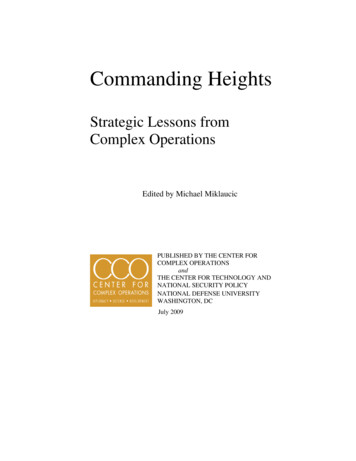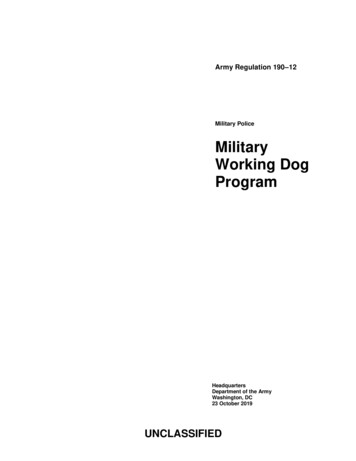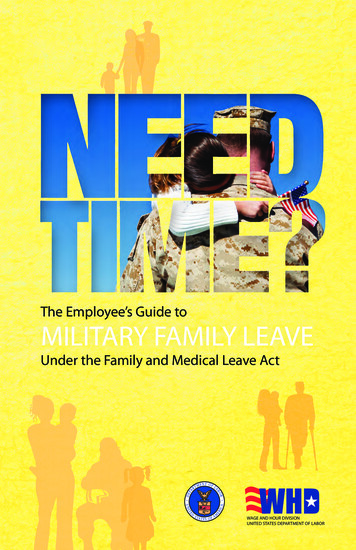
Transcription
Commanding HeightsStrategic Lessons fromComplex OperationsEdited by Michael MiklaucicPUBLISHED BY THE CENTER FORCOMPLEX OPERATIONSandTHE CENTER FOR TECHNOLOGY ANDNATIONAL SECURITY POLICYNATIONAL DEFENSE UNIVERSITYWASHINGTON, DCJuly 2009
The views expressed in these essays are those of the authors and do notreflect the official policy or position of the National DefenseUniversity, the Department of Defense, or the U.S. Government. Allinformation and sources were drawn from unclassified materials.Portions of this book may be quoted or reprinted without permission,provided that a standard source credit line is included.This book was published by the Center for Complex Operations and the Centerfor Technology and National Security Policy, National Defense University,Fort Lesley J. McNair, Washington, DC. CCO publications are availableonline at www.ccoportal.org.
ContentsPrefaceviiBy Hans Binnendijk and David A. SobyraIntroductionixBy Michael MiklaucicEssay 1Command in Afghanistan 2003–2005: ThreeKey Lessons Learned1By David BarnoEssay 2Understanding the Situation9By Frederick BartonEssay 3Reflections on Post-Conflict Politics ofReform: A Voice from Inside Iraq21By Nesreen BarwariEssay 4Preemptive Post-Conflict Stabilization andReconstruction31By Barbara K. BodineEssay 5Lessons Learned in the Fog of Peace39By L. Paul BremerEssay 6Complex Operations in Practice47By Peter W. Chiarelliiii
Essay 7No Formulas: Bosnia, Haiti, and Kosovo55By Wesley ClarkEssay 8The Balkans Revisited: Kosovo 199963By Timothy CrossEssay 9Retaining the Lessons of Nation-Building73By James DobbinsEssay 10Missions Accomplished and Unaccomplished81By Jan EliassonEssay 11The Politics of Complex Operations87By James KunderEssay 12Reconstructing Post-Conflict Reconstruction:Lessons from Iraq95By Lewis W. LuckeEssay 13Effective Civilian-Military Planning at theOperational Level: The Foundation of OperationalPlanning105By H.R. McMasterEssay 14Lessons Learned in Democratic Transition andBuilding Civil Society115By William MontgomeryEssay 15Striking the Right Balance121By William L. Nashiv
Essay 16Understanding and Responding to Fragile andFailed States127By Andrew S. NatsiosEssay 17Implementation in a Multiparty Environment133By Ronald E. NeumannEssay 18Beyond the Cold War: Pakistan and Somalia139By Robert B. OakleyEssay 19Every Complex Operation Needs a BG Rich Ellis149By Thomas W. O’ConnellEssay 20Post-Conflict Reconstruction Challenges:Some Observations from Iraq155By Robin RaphelAbout the Contributors163v
PrefaceBy Hans Binnendijk and David A. SobyraThe Center for Complex Operations (CCO) was establishedwithin the Center for Technology and National Security Policy(CTNSP) at National Defense University in February 2009. Itspurpose is to address a widely perceived need for improved interagencyinteroperability in analysis of, planning for, and intervening in complexoperations worldwide. Complex operations include reconstruction andstabilization operations, counterinsurgency, and irregular warfare—operations that must draw on all elements of national power to succeed.The goal of the CCO is to help improve the effectiveness of U.S. effortsin pursuing our national interests in complex operations, and to savelives.Created as a collaborative initiative by the Departments of State andDefense and the United States Agency for International Development,the CCO represents a whole-of-government approach to complexoperations, and embodies the “three D’s” of diplomacy, defense, anddevelopment. The objectives of the CCO are to: Provide for effective coordination in the preparation of UnitedStates Government personnel for complex operations. Foster unity of effort during complex operations amongo the departments and agencies of the United States Government,o foreign governments and militaries,o international organizations and international nongovernmentalorganizations, ando domestic non-governmental organizations. Conduct research; collect, analyze, and distribute lessons learned;and compile best practices in matters relating to complexoperations.vii
viii Binnendijk and Sobyra Identify gaps in the education and training of Department ofDefense personnel, and other relevant United States Governmentpersonnel, relating to complex operations, and to facilitate effortsto fill such gaps.This ambitious mandate sets a daunting agenda that must beaddressed if the United States is to meet the national securitychallenges of the 21st century. These challenges have evolvedsubstantially during the past two decades. The existential threat ofnuclear warfare that dominated national security thinking for 50 yearsdisappeared with the collapse of the Soviet Union. What ensued wasnot the global peace some had expected and many hoped for. Instead,we entered an era of diffuse and multi-dimensional threats. The enemyis not always obvious. Our national security goals are sometimesunclear. Recent experience in Iraq and Afghanistan has demonstratedthe limits of our understanding of complex operations. It is critical thatwe continue to learn from these experiences. The CCO aims to helpinstitutionalize the practice of effective learning from experience.It is our hope that these essays, which represent 20 different views ofcomplex operations, will convey some sense of the magnitude of thechallenge of complex operations. The essayists include seniordiplomats, development experts, and military leaders with a broadrange of experience, not only from Iraq and Afghanistan, but extendingback to earlier complex operations in the Balkans, Haiti, Somalia, andeven Grenada. From these diverse views should emerge principles thatconstitute the strategic lessons of complex operations.We would like to thank all the authors whose essays appear in thisvolume, as well as the many senior leaders who have pledged tosupport the efforts of the CCO in the future. In particular we want torecognize the efforts of Michael Miklaucic, the CCO Director ofResearch, Information and Dissemination, who edited this volume, andMs. Jacqueline Carpenter, whose energy, passion and creative ideaskept the project moving. We also want to thank the CCO staff—NeylaArnas, Nicholas Brechbill, Bernard Carreau, Dale Erickson,Christopher Maletz, Scott Moore, and Daniel Troy—without whosetireless efforts this volume would not have been possible. Finally, wewould like to thank Lindsey Geddes, Scott Miller, and Robert Ooi fortheir dedicated support throughout this project.
IntroductionBy Michael MiklaucicThe natural tendency of people to view problems from theperspective of their home organization is widely acknowledgedin Washington. The corrosive effect this has on unity of intentand unity of effort is also acknowledged, documented, and lamented.As long as the stakes are small, the costs of such parochialism areapparently endurable. Our recent frustrations in Iraq and Afghanistan,however, have elevated the problem of so-called “stove-piping” to ahigh profile.The proposed remedy to stove-piping is the “whole of government”approach to complex problems. Also known as the “comprehensiveapproach,” the putative advantage of whole of government approachesis that they lift the level of analysis to a higher altitude, providing abetter view of the full extent and complexity of the problem inquestion. The inevitable decrease in resolution, or granularity, shouldbe more than balanced by an improved strategic perspective.Regrettably, however, the discipline of the whole of governmentapproach has not been consistently applied, as bureaucratic inertiapushes back against proposed new practices.Despite countless testimonials of commitment to whole ofgovernment collaboration, true collaboration remains ad hoc anddependent on specific circumstances, rather than institutionally hardwired into the practices and behaviors of departments and agencies.Although efforts are being undertaken to improve collaboration,interagency secondments remain de-incentivized and bureaucraticallycumbersome, thus discouraging the growth of a cadre of whole ofgovernment professionals. Interagency collaboration also remainsstunted by incompatible communications systems, operationalpractices, and organizational cultures.ix
x MiklaucicComplex operations, in which multiple agencies assumecomplementary roles and operate in close proximity—often withsimilar missions but conflicting mandates—accentuate these tensions.The tensions are evident in the processes of analyzing complexenvironments, planning for complex interventions, and implementingcomplex operations. Many reports and analyses forecast that thesecomplex operations are precisely those that will demand our attentionmost in the indefinite future.As essayists Barton and O’Connell note, our intelligence andunderstanding of the root causes of conflict, multiplicity of motivationsand grievances, and dispositions of actors is often inadequate.Moreover, the problems that complex operations are intended andimplemented to address are convoluted, and often inscrutable. Theyexhibit many if not all the characteristics of “wicked problems,” asenumerated by Rittel and Webber in 1973: they defy definitiveformulations; any proposed solution or intervention causes the problemto mutate, so that there is no second chance at a solution; everysituation is unique; each wicked problem can be considered a symptomof another problem. As a result, policy objectives are often compoundand ambiguous. The requirements of stability, for example, inAfghanistan today, may conflict with the requirements for democraticgovernance. Efforts to establish an equitable social contract may wellexacerbate intercommunal tensions that can lead to violence. The ruleof law, as we understand it, may displace indigenous conflictmanagement and stabilization systems. Indeed, the law of unintendedconsequences may be the only law of the land. The complexity of thechallenges we face in the current global environment would suggest theobvious benefit of joint analysis—bringing to bear on any givenproblem the analytic tools of military, diplomatic and developmentanalysts. Instead, efforts to analyze jointly are most often anafterthought, initiated long after a problem has escalated to a level ofurgency that negates much of the utility of deliberate planning.In addition to good analysis, we know that effective planning isessential for the success of a complex operation. However, highlydiverse planning cultures within U.S. Government agencies makeeffective joint planning difficult. Highlighting merely the most obviousdiscrepancy, the U.S. military planning culture, discipline, and capacityis not mirrored in the civilian agencies. State Department planning is,for practical purposes, limited to annual program and budget planning
Introduction xi(using the Mission Program Planning, or MPP, tool), and the planningtools developed recently by the Office of the Coordinator forReconstruction and Stabilization (S/CRS). The most notable product ofthe latter is the Interagency Management System (IMS), developed torationalize the U.S. response to complex stabilization andreconstruction challenges. Interestingly, the IMS has never been fullytested in a real-life situation, and some doubt that it ever will be. TheU.S. Agency for International Development contributes to State’sannual planning exercise, in addition to its own mission countrystrategic plans, which, though atrophied in recent years, are generallybased on a 3- or 5-year planning horizon. The recent announcement bySecretary of State Hillary Clinton of a new Quadrennial Diplomacy andDevelopment Review (QDDR), similar to the Department of DefenseQuadrennial Defense Review (QDR), indicates a step towardcoordinated, if not joint, civilian-military planning. Yet, one must ask ifthe two processes—the QDDR and QDR—will be synchronized andcollaborative. Or will the rush to create a first QDDR result in out-ofsynch reviews?Field operations are, of course, where tensions between the variousorganizations are most evident. The juxtaposition of fighting militaryforces next to humanitarian relief workers, development specialists, anddiplomats can cause significant discomfort. In non-permissiveenvironments such as Iraq and Afghanistan, military forces are calledon to participate substantively and substantially in humanitarian anddevelopment efforts. Humanitarians have raised numerous issues withthis participation, as have development experts. Does the provision byuniformed military of humanitarian services compromise the neutralityof humanitarian workers, and thus put them at greater risk? Does itnarrow the so-called “humanitarian space?” Given the culture, training,and primary mission of military forces, is the “do no harm” philosophyembraced by many in the development and humanitarian communitiesviable? The U.S. military has in recent years generated a large quantityof doctrine that emphasizes the importance of the developmental anddiplomatic elements of national power. The Department of Defense haseven committed itself to developing whatever capacities are necessaryfor stabilization and reconstruction in the absence of the correspondingcivilian capacity, even when a civilian agency would be a moreappropriate provider. Yet, we have not explored whether the politicaland developmental elements of a counterinsurgency campaign are
xii Miklauciccompatible with the democratization and economic elements of longterm, sustainable development.As Ambassador James Dobbins notes in his essay, the United Stateshas unparalleled recent experience in mounting complex operations. Inthe past decade, most agencies of the Federal Government have beenengaged in complex operations some way or another, particularly inIraq and Afghanistan. From this extensive experience we should havelearned a great deal. But have we? George Santayana said, “those whocannot remember the past are condemned to repeat it." Chastened byour recent experiences in Iraq and Afghanistan we Americans havebecome obsessed with learning the lessons of the past. Lessons learnedand best practices have become a growing cottage industry in theinteragency community engaged in overseas complex operations. Yet,we have not institutionalized processes for articulating, validating, anddisseminating lessons from past experience in complex operations. Todate, the civilian departments and agencies lack a systematic approachto learning from experience, and a great deal of information,experience, learning, and, indeed, wisdom is probably lost asindividuals transition to other assignments and vocations.As acknowledged throughout the essays in this volume, the bestapproach to complex operations is a genuine whole of governmentapproach. Joint analysis, planning, and implementation are appropriate,not just on the eve of a complex operation, but on a routine and habitualbasis—in the pre-conflict phase as well as once conflict has begun. Yet,many barriers to effective joint collaborative analysis, planning, andimplementation remain. As 9/11 recedes in memory and Iraq andAfghanistan become part of our quotidian experience in the foreignpolicy world, there is a risk of reverting to old habits of stove-pipingand agency parochialism. Will the whole of government approach thathas become so popular in response to the Iraq and Afghanistanexperiences be limited to those experiences? Will the benefits ofcivilian-military collaboration be disregarded as agencies seek to returnto more “normal” practices? Already it is possible to detect a note ofimpatience to do so, or of whole of government fatigue. If the insightsof these essays are to be trusted, as I believe on the whole they shouldbe, failure to firmly institutionalize a whole of government philosophyand associated practices would be a lamentable mistake, and wouldconstitute an unforgiveable failure to learn the lessons of ourexperience.
Essay 1Command in Afghanistan2003–2005: Three KeyLessons LearnedBy David BarnoThe operational experience and lessons learned described in thisarticle result from my 19 months as the overall commander ofU.S. and coalition forces in Afghanistan from 2003–2005. Asthe senior U.S. commander, I held geographic responsibilities to U.S.Central Command for a sub-region that included all of Afghanistan,most of Pakistan, and the southern portions of Uzbekistan andTajikistan—a four-country joint operations area. My first task uponarrival in theater was to establish a new three-star headquarters inKabul from the ground up, while concurrently assuming overallcommand of ongoing training and combat operations across the entirearea of operations. This unique opportunity provided a host of “lessonslearned” stemming from a set of challenges few other commanders atthat time faced. My command responsibilities spanned a set of tasksbest described on the spectrum of operations as reaching from theaterstrategic/pol-mil through the high end of the operational level; mysubordinate two-star combined joint task force held tactical and lowerend operational level responsibilities across our battlespace.Three key lessons pertaining to strategic and operational command inirregular warfare during this demanding period stand out. First,focusing on the big picture: strategy not tactics, winning not simplybattles, but the war became the central task. Second, the vitalimportance of integrating the civil-military effort, beginning at the mostsenior levels, was crucial to success. Finally, the essential task ofcommunicating and building relationships of trust with key players of1
2 Barnodisparate backgrounds was a prerequisite to achieving effective results.Each of these topics is worthy of an extensive discussion, but this piecewill attempt to summarize the most salient points related to each.Focusing on the big picture seems an obvious principle to promote atthe senior level of military command. Unfortunately, the U.S. Army’scultural predisposition toward “war-fighting” (fighting and winningbattles) versus “war-winning” (bringing conflicts to a successfulconclusion) remains a powerful influence affecting theater levelleadership, so emphasizing the primacy of the big picture deservesstrong reinforcement.Senior commanders are drawn from an environment that rewardstactical level performance. Successful two-star division commandersare drawn from successful colonels and brigadiers who have proventheir mettle not as strategic leaders, but as master tacticians. Three- andfour-star leaders are chosen from successful two-star commanders—thus a predilection toward the importance of tactical performance isreinforced by our promotion and selection system. Senior commandersare often unwittingly pulled toward operating and prioritizing in waysthat have delivered success in their career—a dynamic that often worksat cross purposes with the need to understand leadership in new ways,which is the sine qua non of successful operational and strategiccommand.Moreover, despite the central civil-military dynamic that defineseffective counterinsurgency, the temptation for the U.S. military to “goit alone” and conduct military operations not fully harmonized withcivil action remains a challenge—and one played out on severaloccasions in Afghanistan from 2002-2008. “War-fighting” may notalways require civil players to achieve success—“battles” are won,after all, by soldiers—but the much more complex notion of “warwinning” almost always requires a whole of government efamouscharacterization of French COIN expert David Galula, are often 80percent non-military and only 20 percent military. 1Focusing on the big picture requires a clear understanding of thepolicy goals that the military effort is designed to serve. In most cases1David Galula, Counterinsurgency Warfare: Theory and Practice (Westport,CT: Praeger Security International, 1964).
Command in Afghanistan 2003–2005 3those goals will not be simply military in nature; some degree ofinteragency (and sometimes, international) effort will be required toachieve most policy objectives. This presents military commanderswith a dilemma: how much should they get involved outside themilitary sphere? Commanders will not “command” many of theinteragency actors whose combined actions will be needed to achievethe policy goals handed down from Washington. Conversely, in suchsituations, military leaders may not be held fully accountable for theoutcome. Do military commanders simply “stay in their lane,” work onthe military and security lines of operation, and define their missionstatement narrowly to deliver the “military requirement?” Or docommanders extend their horizons, seek maximum flexibility in theirmission statements, leverage their military capacity (nearly always thebiggest resource available), and drive their organization toward abroader set of whole-of-government policy goals to enable theoverarching policy objectives to be met?From 2003–2005 in Afghanistan, my approach was the latter. As Ishared with an overworked staff officer in my headquarters in late2003, “We own it all.” This outlook was strikingly different from theapproach taken by previous commanders (likely operating under otherguidance). Previous commanders had limited interaction with thecivilian leadership and were operating from a military headquarters thatwas a 90-minute drive outside the capital of Kabul. In fact, my ordersin standing up a new headquarters were explicitly to position it inKabul and build closer connections with the U.S. embassy and newlyarriving U.S. ambassador. This guidance was in belated recognitionthat (by 2003 at least) geographically separating the U.S. civilian andmilitary leadership during a prolonged engagement in Afghanistan wasnot a productive approach.Creating a unified, civil-military approach was a second majorchallenge. Fortunately, our new U.S. ambassador, Zalmay Khalilzad,fully understood this necessity and became an ideal partner in thisformidable task. Personalities matter immensely in conditions of crisis,and ours meshed—no small bit of good fortune! Our staffs began torecognize that there would be no seams or “white space” between theU.S. ambassador and the senior military commander, and thatexpectations were being set for strongly integrated efforts between thetwo organizations. I understood that if the U.S. military “succeeded” inAfghanistan—won every tactical engagement, killed more of the
4 BarnoTaliban—yet the U.S. embassy failed—could not facilitate a nationwide presidential election, could not complete the Ring Road project,failed to disarm and separate warlords—the overall mission would fail,and U.S. policy goals would not be achieved. This was a fundamentalrealization that quickly began to shape all of our military endeavors.The implementation of a unified civil-military approach took amyriad of forms. My day began and ended at the U.S. embassy (whereI also resided in a half-trailer)—to better encounter the ambassador atoff moments. The first 2 hours of the day included meetings with theambassador for country team meetings (to demonstrate our one-teamapproach) and security core group meetings to cross talk among all thesenior U.S. military and interagency players in Afghanistan andsynchronize directions. U.S. military officers were seconded to manyembassy offices, and five senior military planners were provided to theambassador to form an “Embassy Interagency Planning Group” thatwould provide strategic planning for the ambassador and devise metricsand performance measures for the overall U.S. mission in Afghanistan.Ambassador Khalilzad and I would often travel together to key eventsoutside Kabul, and we attended all openings of provincialreconstruction teams (PRTs) together. This close relationship paid usboth huge dividends and was a benchmark for our military anddiplomatic organizations (Defense coming from “Mars” and State from“Venus”), clearly demonstrating the expectations for close andsupportive relations at all levels.Communicating and building relationships with actors of all differentbackgrounds was another critical lesson learned. Military officers areraised and schooled in environments consisting largely of other militaryofficers. The political-military environment of senior command inAfghanistan was anything but military in nature. As the commander ofU.S. Central Command, General John Abizaid, noted in his conciseinitial guidance to me: “Your job, Dave, is big Pol and little Mil,”alluding to the scope of the political-military challenge and thepriorities needed in our new approach. To implement this guidance, Ibegan to spend large portions of my time interacting with the manyactors in Kabul who significantly influenced the overall internationaleffort in Afghanistan. They too would have immense impact on thesuccess or failure of U.S. policy objectives—whether Afghan ministers,ambassadors from NATO nations, or key UN officials.
Command in Afghanistan 2003–2005 5Key to achieving some degree of synergy of effort between thisdiverse set of players were personal relationships. I began to realizeearly in my tenure that building a personal relationship with each ofthese key individuals—something which extended beyond simply goodmanners in office calls—became a “force multiplier,” in militaryparlance, and created a wellspring of good will and trust that might beof substantial future importance. Mutual trust became an essentialingredient to resolving thorny and contentious issues that were inherentin the international effort in Kabul.A salient example of the importance of trust-building was therelationship that evolved between the U.S. military and the UnitedNations in Afghanistan. On a personal level, this was embodied in therelationship that developed between the U.S. military commander andthe Senior Representative of the UN Secretary General (SRSG).Institutionally, these two organizations were highly dissimilar—insome ways from opposing cultures, and populated by dedicated andcommitted individuals of very different backgrounds who largelyviewed each other with suspicion. Given the central importance of theUN mission in Afghanistan to the legitimacy of the internationalmission, as well as to the looming first-ever Afghan presidentialelection, an uncooperative or contentious relationship between the UNand the U.S. military was fraught with peril.At his invitation, the SRSG, Jean Arnault, and I began to havebreakfast every Monday morning at his residence. A Frenchman whowas a career diplomat, Jean was of dramatically different backgroundand interests than any American general. Yet, these informal gettogethers produced not only useful discussions on issues of mutualimportance, but laid the foundation for an increasingly strong personalconnection between Mr. Arnault and myself—one that continues to thisday. We grew to trust each other and to clearly see where our twoorganizations had much in common as we looked to the desiredoutcome in Afghanistan. Moreover, we intuitively realized that neitherof our organizations could accomplish its objectives without the help ofthe other.The importance of a genuine relationship of shared trust andconfidence between two leaders of different organizations wasimmense. Just as with the institutional diplomatic-military benefitsaccruing to my ties to the U.S. ambassador, SRSG Arnault’s and my
6 Barnoorganizations (the UN mission and the U.S. military) quickly began tounderstand that “the bosses got along” and would not brook the “staffwars” that often endanger good relations between institutions withdifferent outlooks and missions. Conversely, the close relationshipbetween the two senior leaders fostered an environment in whichsubordinates could take broad initiatives on a host of issues knowingthat over-arching institutional goals and objectives were shared. Whena crisis might erupt in Afghanistan that threatened the security ofinternational aid workers—four Médecins Sans Frontières physicianswere murdered in early 2004, and MSF left the country—our personalrelationship of trust helped both the United States and the UN evaluatethe threat and react in ways that, absent that personal relationship,might have caused the UN to shut down key parts of its vital operationsacross Afghanistan.Relationships of mutual respect and confidence with host-nationcounterparts are equally crucial in an irregular warfare environment.My senior leader engagements regularly took me to meet with the Chiefof General Staff of the Afghan National Army (ANA), GeneralBismullah Khan. General Bismullah was a Tajik and former mujahidwho had fought the Soviets and then the Taliban for his entire adultlife. Though only in his mid-40s, he was prematurely aged by long,hard fighting. He spoke always through an interpreter, which furthercomplicated dialogue. That said, we struck a very close relationshipand built close ties between our two organizations. Our discussionsover tea in his office were always wide-ranging and often very indirect.The highest compliment I ever received from an Afghan came fromBismullah after I has returned to the United States: “(General Barno)never told us what to do in our meetings, but when he left the office, wealways knew what he wanted us to do.” Indirection and respect forcultural norms had a powerful influence when coming from acommander whose forces were in very real terms guests within thesovereign nation of Afghanistan.In sum, my “lessons learned” boil down to this: theater levelcommand in an irregular warfare setting demands a broader set of skillsthan those required of conventional war at the same level. Some basicquestions arise as to whether our selection and development of seniorofficers for command in this environment adequately recognize thisfact. Our military leaders today are superbly trained and equipped bytheir lifelong experience to lead difficult military contingency
Comma
strategic plans, which, though atrophied in recent years, are generally based on a 3- or 5-year planning horizon. The recent announcement by Secretary of State Hillary Clinton of a new Quadrennial Diplomacy and Development Review (QDDR), similar to the Department of Defense Quadrennial Defense Review (QDR), indicates a step toward










